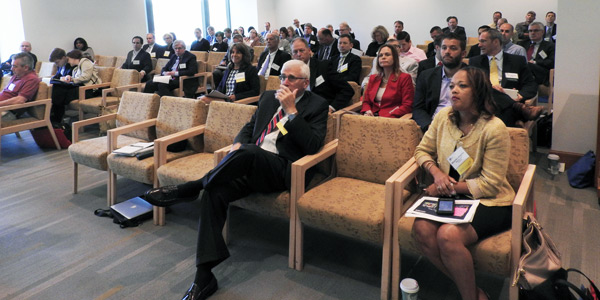By Michael Kuser
POUGHKEEPSIE, N.Y. — New York’s push to derive half its electricity from clean energy by 2030 must be accompanied by regulatory consistency to develop the necessary resources, panelists said at an energy forum last week.
State regulatory policy contains inherent conflicts that hinder renewable development, Paul DeCotis, senior director of energy and utilities at West Monroe Partners, said during the June 28 Renewable Energy Conference, hosted by the Business Council of New York State and the Hudson Renewable Energy Institute at Marist College.
DeCotis, who formerly served as energy secretary and chair of the state energy planning board for two New York governors, led a panel on regulatory structure.
Speaking about Long Island solar projects unlikely to be built because they’re proposed for green space, DeCotis said, “It goes against the policy of the state of New York on the one hand, in terms of renewable energy development, but it supports other green space initiatives. There’s always going to be an inherent policy conflict, which makes these goals even more difficult to attain. So it does take some certainty of regulatory environment, and it takes time.”
DeCotis noted that he and fellow panelist Paul Curran — managing partner of BQ Energy, a Poughkeepsie-based developer of wind and solar projects on brownfield sites — started talking about the state’s need for additional transmission infrastructure investments in 2007. Those projects are likely to come online in 2020.
“That’s 13 years for transmission to be built,” DeCotis said.
Consistency is Key
“I can play by any rules … but to the extent that the rules keep changing, it gets very difficult,” Curran said. “From a regulatory point of view, we love consistency.”
Regarding the troubled solar projects on Long Island, Curran said green space is the wrong location for renewable energy.
“There’s landfills all over the place; there’s brownfields all over the place — that’s the right place,” he said.
BQ didn’t build any transmission lines at the 35-MW wind farm it constructed in Buffalo. The developer spent just $1 to buy disused substations from a shuttered steel plant that used to draw 300 MW.
“We do the same thing with landfills,” Curran said. “There’s five or six landfills in the middle of New York City, nothing else can be done with them … but the closer we get to load centers, New York City, Boston, etc., the more people like Central Hudson [Gas & Electric] value the electricity,” adding that NYISO also recognizes the value of siting generation closer to where it’s consumed.
Regulators Look to Performance

David Pacyna, CEO of North American T&D Group, said that when he talks to utilities about buying technology, “the concept of interconnecting renewables to make the utility assets perform properly under those scenarios of intermittency and so forth are, if not at the top of the list, very close to it.”
NATDG is a private equity fund that buys into technology service providers that sell to utilities in the U.S. and around the world. Prior to working for the company, Pacyna spent 30 years with Westinghouse Electric and Siemens and supervised construction of the Neptune project connecting Long Island with PJM, the Hudson transmission project and the Trans Bay Cable under San Francisco Bay.
“What does take it in hardware and software to make those rules that frustrate all but actually result in electricity coming out of the light socket?” asked Pacyna. “There’s a growing recognition [by regulators] of the need to invest in the grid.”
On rate designs, Pacyna said regulators in states such as Missouri and Illinois are starting to ask how they can best structure rates to incentivize investment in both grid modernization versus the grid of the future.
“Regulators also are asking how they can use performance-based rates to support investment in distributed energy and renewable resources,” he said.
Lack of a Trump Effect

Ray Wuslich, partner at Winston & Strawn, thought it would be easy to make a presentation in Poughkeepsie about the impact of the Trump administration on the power industry. But when he looked at President Trump’s energy policies, he found “there wasn’t much to go on.”
“We haven’t had any big ideas in the energy space, in energy policy, in over 25 years … really going back to the 1980s when FERC and Congress started looking at competition on the natural gas side and unbundling supplies from the pipeline transportation business,” Wuslich said. “It was crystalized in the Energy Policy Act of 1992 … and everything we’ve been doing since then has been evolutions of that.”
Former President Barack Obama pushed EPA’s Clean Power Plan, which Trump made a campaign issue for its impact on the coal industry, Wuslich noted. Now that Trump has called for repeal of the CPP, which may take up to five years to achieve, “the question is, can the repeal of that rule really save the coal industry and resurrect coal-fired generation?”
Wuslich cited the obstacles facing coal: economics (that is, cheaper, more efficient natural gas); an aging coal fleet; unfavorable state policies; renewable portfolio standards in 29 states and D.C.; major corporations that are focusing on sustainability and clean energy; and the apathy of utility executives, who are not rushing out to build new coal plants.
He noted that a recent Energy Information Administration report said repeal of the CPP could boost the prospects for coal.
“But does this make sense? Does this reflect reality, given where we are in the marketplace?” Wuslich asked. “There’s hardly a week goes by where you don’t see another blurb in the trade press that so and so is going to shut down 500 MW of coal, or 300 or 1,500 or whatever. It’s just a constant drip of these plants retiring, and that’s because of the market.”






